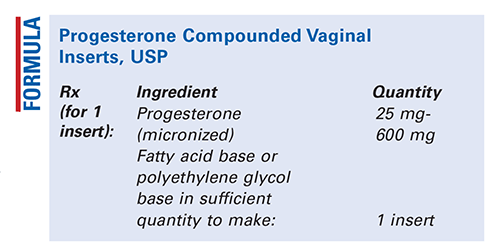US Pharm. 2021;46(9):60-CV3.

Method of Preparation: Calibrate the actual molds with the base that is used for preparing the inserts, and adjust the formula accordingly. Calculate the required quantity of each ingredient for the total amount to be prepared. Accurately weigh/measure each ingredient. Heat the base slowly and evenly until melted. Slowly add the progesterone powder to the melted base while stirring. Mix thoroughly and pour into molds. If inserts are being prepared in fatty acid base, cool in a refrigerator until solidified; then trim and wrap. If inserts are being prepared in polyethylene glycol base, cool, trim, and wrap. Package and label.
Use: Progesterone vaginal inserts have been used in bioidentical hormone-replacement therapy.
Packaging: Package in tight, light-resistant containers.
Labeling: Keep out of reach of children. Discard after ____ [time period]. Use only as directed. For vaginal use.
Stability: A beyond-use date of not more than 90 days when stored in a refrigerator may be used for this preparation.1
Quality Control: Quality-control assessment can include weight, specific gravity, active drug assay, color, texture of surface, appearance, feel, melting test, dissolution test, physical observation, and physical stability.2,3
Discussion: Numerous formulations for almost any patient situation are available to meet the needs of specific patients as ordered by a physician. The formulation presented here is an official USP formula to be used when progesterone vaginal inserts are ordered. The beyond-use date for this formulation is supported by valid stability-indicating analytical methods.
Progesterone is a naturally occurring progestin that occurs as a white or creamy white, crystalline powder; it is practically insoluble in water, soluble in alcohol, and sparingly soluble in vegetable oils. Progesterone melts at about 126°C to 131°C and exists as a polymorph that melts at 121°C. Progesterone, which is extensively metabolized by the liver, may be administered orally, topically, vaginally, nasally, and parenterally.1,4
Fatty acid base, also called hard fat USP, is a mixture of glycerides of saturated fatty acids. These suppository bases consist mainly of mixtures of the triglyceride esters of the higher saturated fatty acids (C8-C18) with varying proportions of monoglycerides and diglycerides. Numerous products are available that can be selected based on their physical properties, including acid value, hydroxyl value, iodine value, melting point, saponification value, solidification point, and unsaponifiable matter. The labeling of these products includes the nominal melting temperature—between 27°C and 44°C. The product should be preserved in tight containers at a temperature that is 5°C or more below the melting range stated in the labeling. Hard fat occurs as a white mass that is almost odorless and free from rancid odor. It is greasy to the touch, and when warmed it melts to become a colorless or slightly yellowish liquid. When the melted material is shaken with an equal quantity of hot water, a white emulsion is formed. Hard fat is practically insoluble in water and slightly soluble in alcohol, and it is freely soluble in ether. Cocoa butter is one type of hard fat.1,5
Polybase is just one example of a polyethylene glycol base, which is a preblended water-soluble, water-miscible suppository base consisting of a homogenous mixture of various-molecular-weight polyethylene glycols. Polybase contains polyethylene glycols (average molecular weight about 3,440) and polysorbate 80. This ingredient is used in the preparation of suppositories and lozenges for which a water-soluble or water-miscible base is preferred. It releases its medication by dissolving in the local fluids. Polybase, a white solid with a mild polyethylene glycol odor, has a specific gravity of 1.177. It is nonirritating and melts at a range of 50°C to 60°C. The release of the drug is independent of the melting point, and the drug may be also used vaginally. Preparations compounded from this base should not be stored or dispensed in polystyrene containers.6
REFERENCES
1. U.S. Pharmacopeia/National Formulary [current revision]. Rockville, MD: U.S. Pharmacopeial Convention, Inc; August 2021.
2. Allen LV Jr. Summary of quality-control testing for sterile and nonsterile compounded preparations, part 1: physical and chemical testing. IJPC. 2019;23(3):211-216.
3. Allen LV Jr. Summary of quality-control testing for sterile and nonsterile compounded preparations, part 2: microbiological testing. IJPC. 2019;23(4):299-303.
4. McEvoy GK, ed. AHFS Drug Information 2016. Bethesda, MD: American Society of Health-System Pharmacists; 2016:3327-3328.
5. Moreton RC. Suppository bases, hard fat. In: Sheskey PJ, Hancock BC, Moss GP, Goldfarb DJ, eds. Handbook of Pharmaceutical Excipients. 9th ed. London, England: Pharmaceutical Press; 2021:1059-1064.
6. Polypeg suppository base. www.medisca.com/Pages/ProductDetails.aspx?StockCode=0746&C=B&C2=113. Accessed July 19, 2021.
The content contained in this article is for informational purposes only. The content is not intended to be a substitute for professional advice. Reliance on any information provided in this article is solely at your own risk.
To comment on this article, contact rdavidson@uspharmacist.com.





